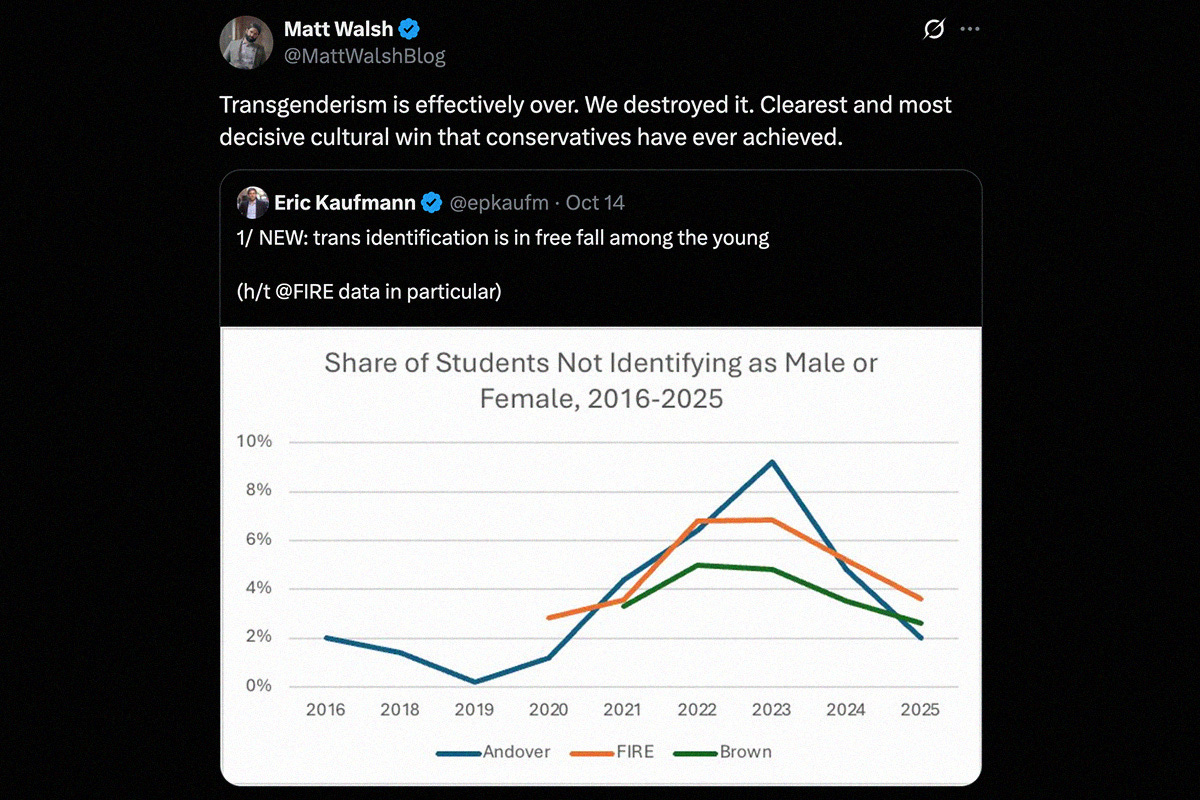No, Kids Haven’t Suddenly Stopped Identifying As Nonbinary
Right-wing media is claiming that young people have stopped identifying as nonbinary. They're wrong!
There are three kinds of lies: lies, damned lies, and statistics.
That quote, often attributed to former British prime minister Benjamin Disraeli, gained ever-renewed relevance in the past week following a headline-grabbing claim that students in the United States are no longer identifying as nonbinary. The allegation originated with a study from the Center for Heterodox Social Science claiming to draw on surveys from the Foundation for Individual Rights and Expression and the Higher Education Research Institute, among others, indicating that nonbinary identification has plummeted among young people. At Brown University, students are (allegedly) half as likely to identify outside the binary in 2025 as they were three years ago: from 5% down to 2.6%.
The research was breathlessly cited by outlets like The Daily Mail, Newsweek, and Vice to drum up clicks and immediately deployed as agitprop by anti-LGBTQ+ outfits like The Manhattan Institute and The Billy Graham Evangelistic Association. Whilst quote-tweeting the data, far-right extremist Matt Walsh deemed the trans movement “effectively over.” “We destroyed it,” he said in an October 14 tweet. “Clearest and most decisive cultural win that conservatives have ever achieved.”
But among the myriad factual issues with proclaiming the end of nonbinary people, the most glaringly obvious is that the data on which their declarations rest is transparently, nakedly, laughably wrong. In my humble opinion, everyone who has cited this research without even the tiniest asterisk next to it should be absolutely ashamed, if this toxic country has any shame left to feel.
As others have already pointed out, the Canadian academic who originally posted the data on X, University of Buckingham’s Eric Kaufmann, grossly mischaracterized the research. He claimed that the numbers illustrated that “trans identification is in free fall among the young,” when that isn’t what they showed at all. Even if the figures happened to be 100% accurate (we’ll get to that), they solely refer to students who do not identify as strictly male or female — whether they consider themselves to be both genders, somewhere in the middle of the spectrum, or neither male nor female. Other kinds of trans people are not indicated.
Before making bold claims about data, one may consider it helpful not merely to be able to read it correctly but to know how to collect it to begin with. That basic, foundational knowledge likewise appears to be lacking: The researchers behind the report forgot to weight the data to make sure that the findings were nationally representative, ensuring that they ended up with skewed, largely useless results. To wit, if I polled 100 people to make claims about the views of U.S. voters, but 96% of respondents were white, it wouldn’t be an accurate cross-section of the country’s population (which is about 59% white). When the sample is weighted correctly, the data indicates that nonbinary identification is increasing, not shrinking, as journalist Erin Reed reported at length.
And even if the data had shown the thing it does not — which is a drop in young people outwardly identifying as nonbinary — that is still a very different thing than actually being nonbinary. There are many reasons that a nonbinary youth might not indicate themselves as such on a public-facing survey, such as the ubiquitous presence of a federal administration hostile to their very existence. Just over a month after U.S. President Donald Trump took office for a second time, he issued a sweeping executive order rewriting the federal definition of gender as exclusively male and female — thereby erasing all those who live their lives outside those definitions.
The explanation that nonbinary young people are increasingly terrified of visibility, even in the form of a seemingly harmless college survey, might seem a too-neat explanation, but it’s hardly a far-fetched one. As the White House progresses in its crusade to criminalize gender-affirming care and persecute the doctors who provide it, the administration has demanded confidential data from hospitals that treat trans youth patients, in violation of federal law. Why wouldn’t students then conclude that Trump officials might try the same thing at their college? Such a concern may be particularly worrying to some in a year that has seen countless universities bow to the Oval Office’s demands, including closing their campus LGBTQ+ centers.
As an investigative reporter who has spent more than a decade covering the LGBTQ+ community, I have witnessed firsthand how profoundly fearful young people are amid the current presidency. Nervous that they could be the next target, many families that I have worked with over the years have either fled their home state and moved to a more liberal community or left the country. This used to be the case only with high-income families that could afford to do so; now even those who don’t have any expendable income to spare on a costly move are figuring out how to get to safety. Nearly every single week, another family that I know feels they have no choice but to run.
It hardly needs explaining that, if a nonbinary young person’s family has fled the country in fear of being criminally prosecuted as child abusers, they are not available to take a college survey at a university they are not present to attend. But even nonbinary kids who have remained in the U.S. are hiding, in their own ways. Many have gone stealth, and their parents have gone off the grid for their family’s well-being. They have stopped doing any form of public advocacy whatsoever, focusing on mere survival. Last October, I published American Teenager — a nonfiction book highlighting the lived experiences of trans and nonbinary youth — and almost none of the eight children whom I profiled would have signed up for that project today. Three have been forced to move to safer states with Trump in office, and one left the U.S. altogether.
And trust me, kids aren’t the only scared people. Adults are, too. In all my years of LGBTQ+ journalism, I have never found it so difficult to get interviews for my coverage, even for stories that are fairly low stakes. An activist whom I have known for many years refused to be quoted (even very briefly) in a fluffy human interest piece, all because she is so petrified of being doxxed and harassed by right-wing trolls. Who can blame her? When the Federal Bureau of Investigation is talking about classifying trans people as terrorists, being out and proud, while absolutely worthwhile, comes with very real dangers.
What is reassuring, though, is how many people haven’t been forced back into the closet by the Trump administration or any other fascist enterprise. According to Gallup’s polling data, LGBTQ+ identification has consistently increased for every single survey since 2012, and its most recent report saw the biggest single-year jump on record: a 1.7% bump. Members of Generation Z — the group falsely alleged to be going back into the closet en masse — are the most likely to identify themselves as queer: at 23%.
Although we do not yet have 2025 data, it’s unlikely these trends will abate all that significantly. Given that the number of respondents willing to tell Gallup that they are LGBTQ+ also increased the last time Trump was in office, it stands to reason that people will continue coming out and claiming their identities, just as they always have.
For as long as Trump remains in power, far-right culture warriors are going to continue grasping at every possible straw to try and prove that they have won. When it is necessary to invent victory, they will do so. If anyone is looking for an easy way to call their bluff, just read the fine print: The Center for Heterodox Social Science is an explicitly anti-social justice think tank housed at a U.K. university with close ties (by its own admission) to the late Prime Minister Margaret Thatcher, an anti-LGBTQ+ conservative. Kaufmann, who boosted the research, is an anti-woke professor who has previously suggested that LGBTQ+ identification is linked to mental illness and claimed that people are being socially pressured into being queer.
So please, next time, check the source. And if you’re a journalist looking to confirm whether or not nonbinary people are still here, give me a call. We are. I am.






